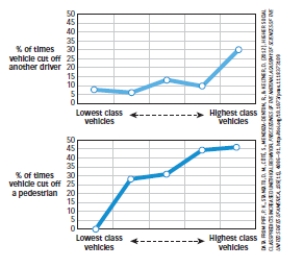Use the following to answer questions
Scenario I
Scenario I is based on and presents data from the following study (reproduced from p.25 of the textbook) :
Piff,P.K. ,Stancato,D.M. ,Côté,S. ,Mendoza-Denton,R. ,& Keltner,D.(2012) .Higher social class predicts increased unethical behavior.PNAS Proceedings of the National Academy of Sciences of the United States of America,109(11) ,4086-4091.doi:10.1073/pnas.1118373109
Piff and colleagues (2012) used naturalistic observation techniques to determine if wealthy people behaved more or less ethically than people who were not wealthy.In one study,observers stood at a busy intersection and recorded the make,model,and year of each approaching car.They also noted if the car cut off other cars or pedestrians at this intersection.
Major findings of Piff et al.(2012) are presented in Figure 1.1.This figure shows the percentage of times vehicles cut off another driver (top panel) or pedestrians (lower panel) as a function of the social status of the vehicles (with more expensive cars ranked higher in social status) .
Figure 1.1 
-(Scenario I) Consider only the bottom panel in Figure 1.1.These results demonstrate that:
Definitions:
Ethnocentric View
A perspective that evaluates other cultures and practices based on the standards of one's own culture, often fostering a sense of superiority.
Generic Strategies
A framework in business strategy that outlines three main approaches a business can take to gain competitive advantage: cost leadership, differentiation, and focus.
Differentiation
The process of distinguishing a product, service, or business from competitors in order to attract a particular target market.
Cost Leadership
A business strategy focusing on gaining advantage by reducing production or service costs below those of competitors.
Q1: Darley and Gross (1983)showed participants a video
Q1: Karen also needs to estimate her internal
Q3: The research of _,in which the maze
Q4: The third-variable problem means that the possibility
Q6: Now that a tentative agreement had been
Q8: Up to this point,prior to Karen Liu
Q49: Kenneth Clark's research on prejudice,discrimination,and segregation was
Q96: William James brought Wundt's structuralist school of
Q195: The less children watch violent television programming,the
Q276: The results from the classic experiment involving